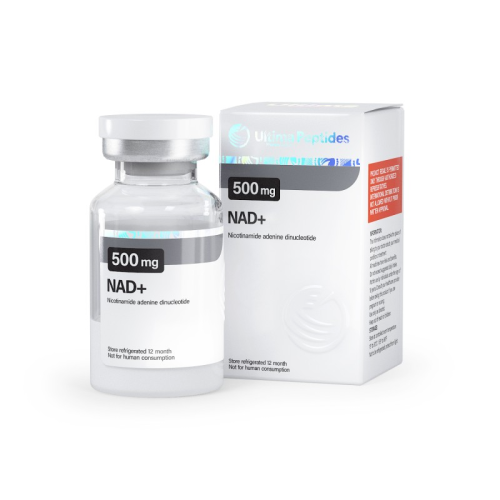Ultima-NAD+
- Brand: Ultima Pharmaceuticals - US
- Product Code: Ultima-NAD+
- Availability: In Stock
-
$120.00
MANUFACTURER
Ultima Pharmaceuticals - US
WAREHOUSE
USA Warehouse 5
SUBSTANCE
Nicotinamide Adenine Dinucleotide
,
Nicotinamide adenine dinucleotide (NAD⁺) is a crucial cofactor present in every living cell, necessary for the functioning of enzymes that support vital biological processes. First identified in 1906, research has increasingly highlighted the importance of NAD⁺ in sustaining the well-being of our cells, tissues, and overall health.
Aging leads to a gradual decrease in NAD⁺ levels, a decline associated with various age-related diseases, such as cognitive impairment, cancer, metabolic disorders, sarcopenia (the loss of muscle mass and strength due to aging), and frailty. Restoring NAD⁺ levels may slow or even reverse many of these conditions.
What exactly is NAD⁺? How is it produced and utilized by our cells? Exploring these questions is crucial for understanding NAD⁺'s role in promoting healthy aging and determining treatment options for NAD⁺ deficiencies.
Where is NAD⁺ Located in the Cell?
NAD⁺ is distributed in distinct areas within the cell, including the cytoplasm, mitochondria (the cell's energy producers), and the nucleus (where genetic material is stored). These subcellular NAD⁺ pools are independently managed, and the enzymes involved in NAD⁺ synthesis and breakdown are also compartmentalized.
How do Cells Synthesize NAD⁺?
NAD⁺ plays a vital role in numerous biological processes and is continuously produced, metabolized, and recycled to keep intracellular NAD⁺ levels stable. Some cells, particularly in the liver, can create NAD⁺ from the ground up using various dietary components, such as L-tryptophan or vitamin precursors like nicotinic acid (NA).
Outside of the liver, most cells lack the complete set of enzymes to convert tryptophan into NAD⁺. Instead, NAD⁺ can be salvaged from nicotinamide (NAM), a by-product of NAD⁺-dependent enzymatic reactions. In the liver, most tryptophan is converted to NAM, which then enters the bloodstream, is taken up by other cells, and ultimately transformed into NAD⁺. In this process, NAM is converted to nicotinamide mononucleotide (NMN) by the enzyme NAMPT, which can further convert into NAD⁺. NMN can also be synthesized from nicotinamide riboside (NR).
Enzymes that Utilize NAD⁺
NAD⁺ is continuously utilized by three main types of enzymes: sirtuins, PARPs (poly(ADP-ribose) polymerases), and NAD+-glycohydrolases (often referred to as NADases), including CD38, CD157, and SARM1.
Sirtuins
Research into the relationship between NAD⁺ and aging has spotlighted sirtuins, which are crucial for regulating metabolic functions, stress responses, and aging processes.
PARPs
The family of PARP proteins consists of 17 members, involved in breaking down NAD⁺ into NAM and ADP-ribose. Targeting PARPs, particularly PARP1, presents a promising therapeutic approach in the context of aging, although further studies are needed to clarify their role in the decline of NAD⁺ levels with age.
NADases
CD38 and CD157 are multifunctional enzymes located on the cell membrane. CD38 influences vital cellular activities such as immune response, survival, and metabolism. Both CD38 and CD157, which use NMN and NR as alternative substrates, respectively, are upregulated in aging tissues and may contribute to age-related diseases such as arthritis and cancer.
Recently, SARM1 was identified as a member of the NADase family. It is predominantly found in neurons and contributes to neuronal development and inflammation, while also being present in certain immune cells. SARM1 is emerging as a target for therapies aimed at preventing or alleviating neurodegenerative diseases and brain injuries.
Other Roles of NAD⁺ in Cells
Beyond being utilized by the main enzyme groups described, NAD⁺ acts as a crucial cofactor for over 300 enzymes involved in various biochemical reactions. It mediates significant cellular functions and metabolic adjustments, including metabolic pathways, DNA maintenance and repair to ensure genomic stability, and autophagy, the recycling process of the cell. Collectively, these functions are vital for overall health, but as NAD⁺ levels decline with age, these processes can be disrupted, worsening age-related diseases.
The Connection Between NAD⁺ and Aging
As we age, NAD⁺ levels decrease, and many enzymes responsible for NAD⁺ metabolism are altered. Multiple cellular processes—regulating or influenced by aging—such as metabolic dysfunction, impaired DNA repair, genomic instability, inflammation, cellular aging, and neurodegeneration, are affected by NAD⁺ levels. This decline has been linked to the emergence and progression of age-associated diseases like atherosclerosis, arthritis, hypertension, cognitive decline, diabetes, and cancer.
Restoring NAD⁺ Levels
NAD⁺ levels can be partially restored through dietary sources like NMN, NR, and NAM. Additionally, cellular NAD⁺ levels might be boosted through the activation of biosynthesis enzymes or the inhibition of NAD⁺-degrading enzymes. For instance, inhibiting CD38 and CD157 may enhance the efficacy of common NAD⁺ precursors in restoring NAD⁺ levels in older adults.
Moreover, strategies to elevate NAD⁺ levels include lifestyle modifications, such as increasing physical activity, reducing calorie intake, maintaining a healthy diet, and establishing a consistent daily routine aligned with healthy sleep patterns and meal times.
Research has highlighted the importance of sleep and circadian rhythms, which are regulated by the brain's suprachiasmatic nucleus (SCN) and influence our sleep-wake cycles. Various factors, including environment, diet, and exercise, as well as individual chronotypes, affect this natural rhythm, dictating when we feel alert or fatigued.
Overall, these strategies not only support tissue NAD⁺ levels but also contribute to improved organ function, cognitive health, metabolic well-being, reduced inflammation, and enhanced physical activity, which may collectively extend healthspan and potentially lifespan.

